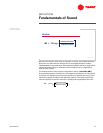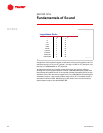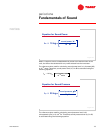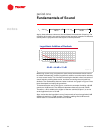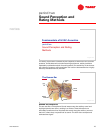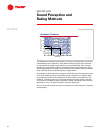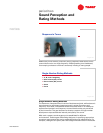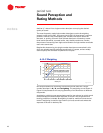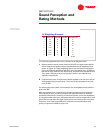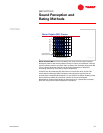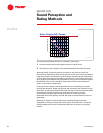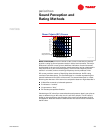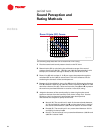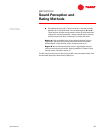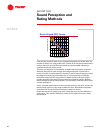
TRG-TRC007-EN 19
period two
Sound Perception and
Rating Methods
notes
The following steps describe how to calculate an A-weighted value.
1 Starting with the actual sound-pressure levels for the eight octave bands,
add or subtract the decibel values represented by the A-weighting curve
shown in Figure 23. These weighting factors are also listed in the table in
Figure 24. Subtract 26 dB from the 63 Hz sound-pressure level, 16 dB from
the 125 Hz level, 9 dB from the 250 Hz level, and 3 dB from the 500 Hz level.
Then, add 1 dB each to the sound-pressure levels in the 2,000 Hz and
4,000 Hz octave bands.
2 Logarithmically sum all eight octave bands together to arrive at an overall
A-weighted sound-pressure level. This value is then expressed using the
units of dBA.
For the sound-pressure data in this example, the A-weighted sound-pressure
level is 42 dBA.
Most sound meters can automatically calculate and display the A-weighted
sound-pressure level, providing a simple and objective means of verifying
acoustical performance. However, as mentioned earlier, one of the drawbacks
of a single-number descriptor is that data about the relative magnitude of each
octave band is lost when the eight octave bands are combined into one value.
Therefore, even if the target dBA level is achieved, an objectionable tonal
quality or spectrum imbalance may exist.
A–Weighting Example
octave
band
1
2
3
4
5
6
7
8
octave
band
1
2
3
4
5
6
7
8
center
frequency (Hz)
63
125
250
500
1,000
2,000
4,000
8,000
center
frequency (Hz)
63
125
250
500
1,000
2,000
4,000
8,000
A-weighting
factor (dB)
–26
–16
–9
–3
+ 0
+ 1
+ 1
+ 0
A-weighting
factor (dB)
–26
–16
–9
–3
+ 0
+ 1
+ 1
+ 0
actual sound
pressure (dB)
63
52
45
38
31
24
16
10
actual sound
pressure (dB)
63
52
45
38
31
24
16
10
A-weighted
sound pressure (dB)
37
36
36
35
31
25
17
10
42 dBA
A-weighted
sound pressure (dB)
37
36
36
35
31
25
17
10
42 dBA
Figure 24



